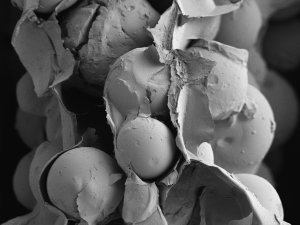
Nanocellulose can also form structures known from pulp technology with the particles. Photo: Bruno Mattos / Aalto University
Nanocelluloses have strong binding properties, allowing them to act like a mortar between particles. In a new paper out today in Science Advances, the Aalto University team and collaborators at the Brazilian Agricultural Research Corporation demonstrate how its ability to organize itself in a multitude of different ways around particles is key to inducing high cohesion in particulate materials. What’s more, the team has found that it can do so in a constant and controlled manner for almost all particle types, which means they can be engineered predictably for applications.
Using nanocellulose, materials built from particles can be formed into any shape using an extremely easy and spontaneous process that only needs water. From particles as small as 20 nanometers in diameter to those that are 20,000 times larger, whether water-repellent or attracted to water, these findings show “a powerful and generic method, a new alternative that bridges colloidal science, material development and manufacturing”, according to Prof. Orlando Rojas, who is a co-author on the paper.
You can read the paper on Science Advances here.
For more information, see aalto.fi news in English and in Finnish.